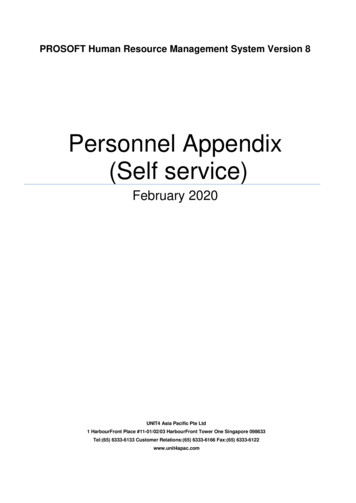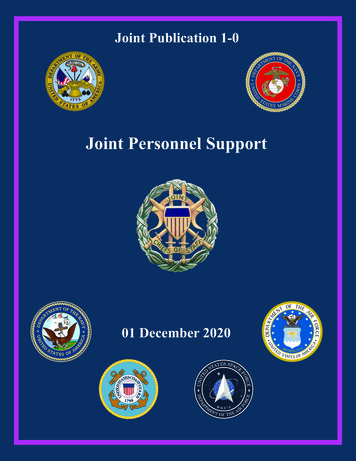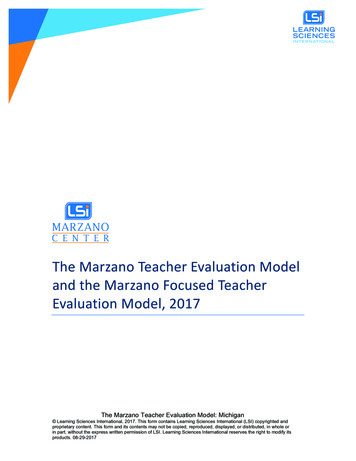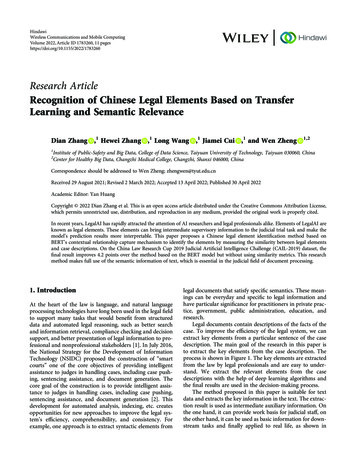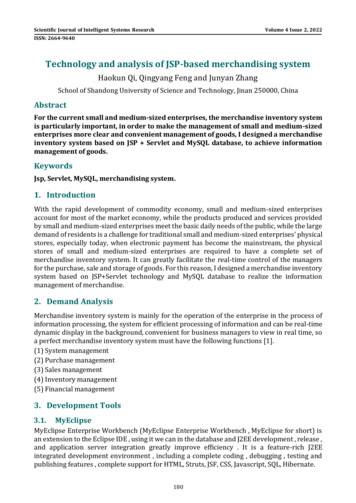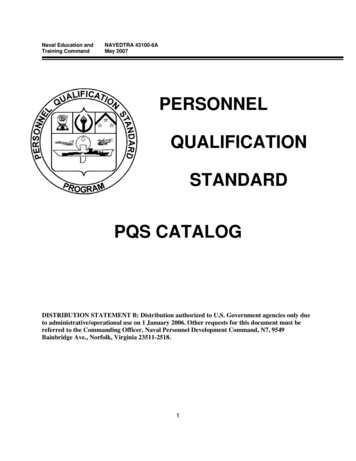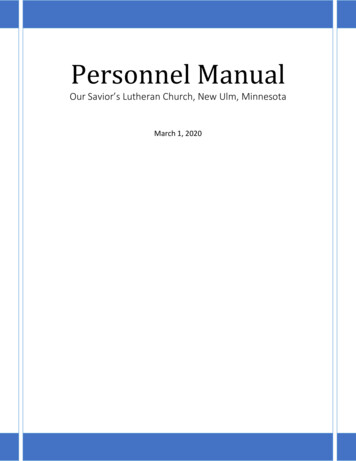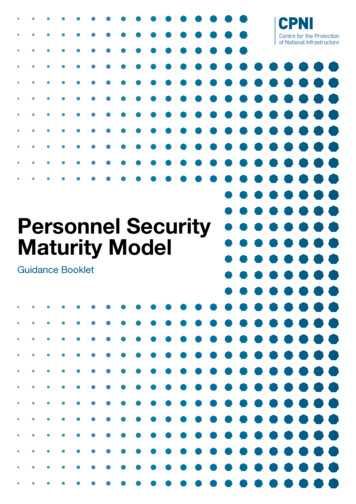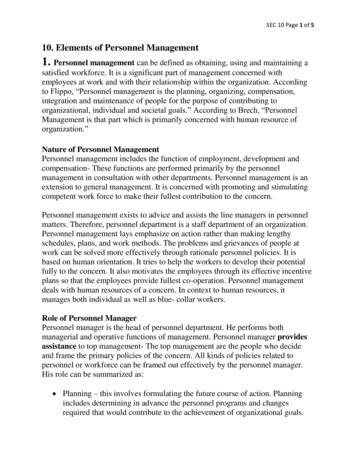
Transcription
SEC 10 Page 1 of 510. Elements of Personnel Management1. Personnel management can be defined as obtaining, using and maintaining asatisfied workforce. It is a significant part of management concerned withemployees at work and with their relationship within the organization. Accordingto Flippo, “Personnel management is the planning, organizing, compensation,integration and maintenance of people for the purpose of contributing toorganizational, individual and societal goals.” According to Brech, “PersonnelManagement is that part which is primarily concerned with human resource oforganization.”Nature of Personnel ManagementPersonnel management includes the function of employment, development andcompensation- These functions are performed primarily by the personnelmanagement in consultation with other departments. Personnel management is anextension to general management. It is concerned with promoting and stimulatingcompetent work force to make their fullest contribution to the concern.Personnel management exists to advice and assists the line managers in personnelmatters. Therefore, personnel department is a staff department of an organization.Personnel management lays emphasize on action rather than making lengthyschedules, plans, and work methods. The problems and grievances of people atwork can be solved more effectively through rationale personnel policies. It isbased on human orientation. It tries to help the workers to develop their potentialfully to the concern. It also motivates the employees through its effective incentiveplans so that the employees provide fullest co-operation. Personnel managementdeals with human resources of a concern. In context to human resources, itmanages both individual as well as blue- collar workers.Role of Personnel ManagerPersonnel manager is the head of personnel department. He performs bothmanagerial and operative functions of management. Personnel manager providesassistance to top management- The top management are the people who decideand frame the primary policies of the concern. All kinds of policies related topersonnel or workforce can be framed out effectively by the personnel manager.His role can be summarized as: Planning – this involves formulating the future course of action. Planningincludes determining in advance the personnel programs and changesrequired that would contribute to the achievement of organizational goals.
SEC 10 Page 2 of 5 Organizing – it involves establishing an intentional structure of roles forpeople in an organization. Structural considerations such as the chain ofcommand, division of labor, and assignment of responsibility are party of theorganizing function. The organizing function establishes relationshipsamong employees so that they can contribute collectively towards theattainment of an organization’s goals. Staffing – This is the process of obtaining and maintaining capable andcompetent personnel in various positions at all levels. It broadlyencompasses manpower planning, recruitment, placement, induction andorientation, transfer, career progression, promotion and separation. Directing – it involves directing all the available resources towards thecommon organizational goals. Thus, direction is a vital managementfunction, which ensures maximum employee contribution and also helps inestablishing sound industrial and human relations. It also involvescoordination between different departments. He advices the line manager as a staff specialist- Personnel manager actslike a staff advisor and assists the line managers in dealing with variouspersonnel matters. As a counselor,- As a counselor, personnel manager attends problems andgrievances of employees and guides them. He tries to solve them in best ofhis capacity. Personnel manager acts as a mediator- He is a linking pin betweenmanagement and workers. He acts as a spokesman- Since he is in direct contact with the employees, heis required to act as representative of organization in committees appointedby government. He represents company in training programs.2. Following are the elements of Personnel Management:Organization- Organization is said to be the framework of many activities takingplace in view of goals available in a concern. An organization can be called as aphysical framework of various interrelated activities. Right from manpowerplanning to employees’ maintenance, all activities take place within thisframework. The nature of the organization is dependent upon its goal-profitmaking.
SEC 10 Page 3 of 5Clubs, hospitals, schools, etc. their goal is service. The objective of consultancy isproviding sound advice. Therefore, it is organizational structure on which theachievement of goals of an enterprise depends upon.In personnel management, a manager has to therefore understand the importance oforganizational structure.Job- The second element, i.e., jobs tells us the activities to be performed in theorganization. It is said that the goals of an enterprise can be achieved only throughthe functional department in it. Therefore, seeing the size of organization today, thenature of activities is changing. In addition to the three primary departments,personnel and research department are new additions. Various types of jobsavailable are:Physical jobsCreative jobsProficiency jobsIntellectual jobsConsultancy jobsTechnical jobs3. People- The last and foremost element in personnel management is people. In aorganizational structure, where the main aim is to achieve the goals, the presenceof manpower becomes vital. Therefore, in order to achieve departmental goals,different kinds of people with different skills are appointed. People form the mostimportant element of the organization without them structure is meaningless.It helps to achieve the goals of the enterprise.Peoplehelp in manning the functional areas.help in achieving the functional departmental goals.people make a concern operational.people give life to a physical organization.The different types of people which are generally required in a concern are:Physically fit peopleCreative peopleIntellectualsTechnical peopleProficient and skilled people
SEC 10 Page 4 of 5In personnel management, a personnel manager has to understand the relationshipof the three elements and their importance in organization. He has to understandbasically three relationships:Relationship between organization and jobRelationship between job and peopleRelationship between people and organizationRelationship between organization and job helps making a job effective andsignificant. Relationship between job and people makes the job itself important.Relationship between people and organization gives due importance toorganizational structure and the role of people in it.4. Personnel RecordsVital to Personnel Management are its records of employees. PersonnelRecords are records pertaining to employees of an organization. These records areaccumulated, factual and comprehensive information related to concern recordsand detained. All information with effect to Personnel Management in theorganization is kept in a systematic order. Such records are helpful to a manager invarious decision-making areas.Personnel records are maintained for formulating and reviewing personnel policiesand procedures. Complete details about all employees are maintained in personnelrecords, such as, name, date of birth, marital status, academic qualifications,professional qualifications, previous employment details, etc.Types of Personnel Records1. Records of employment contain applicants past records, list sources,employee’s progress, medical reports, etc.2. Wages and salaries records contain pay roll records, methods of wages andsalaries, leave records, turnover records and other benefit records.3. Training and development contains appraisal reports, transfer cases, trainingschedule, training methods.4. Health and safety records include sickness reports, safety provisions,medical history, insurance reports, etc.
SEC 10 Page 5 of 55. Service Records are the essential records containing bio-data, residential andfamily information, academic qualifications, marital status, past address andemployment records.Purposes of Personnel RecordsAccording to the critics of personnel records, this system is called as wastage oftime and money. Dale Yoder, an economist of Michigan University, USA hasjustified the significance of personnel records after making an in-depth study.1. It helps to supply crucial information to managers regarding the employees.2. To keep an update record of leaves, lockouts, transfers, turnover, etc. of theemployees.3. It helps the managers in framing various training and development programson the basis of present scenario.4. It helps the government organizations to gather data in respect to rate ofturnover, rate of absenteeism and other personnel matters.5. It helps the managers to make salary revisions, allowances and other benefitsrelated to salaries.6. It also helps the researchers to carry in- depth study with respect to industrialrelations and goodwill of the firm in the market.Therefore, personnel records are really vital for an organization and are not awasteful exercise.
10. Elements of Personnel Management 1. Personnel management can be defined as obtaining, using and maintaining a satisfied workforce. It is a significant part of management concerned with employees at work and with their relationship within the organization. According to Flippo, "Personnel management is the planning, organizing, compensation,

